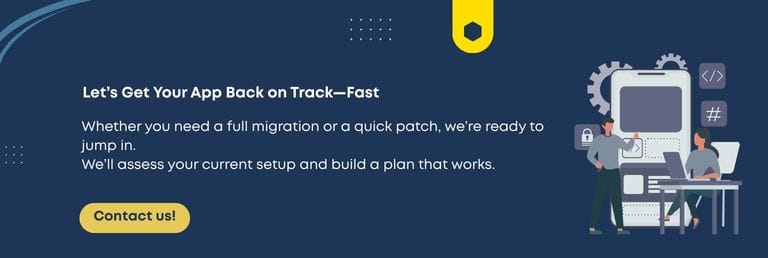No More FFmpegKit? Don’t Panic—Here’s What’s Next
Keyur Patel
September 12, 2025
5 min
If your mobile app’s video features suddenly stopped working and CI builds began failing overnight, you’re not alone. Many developers woke up to broken playback, failed transcodes, and mysterious errors in pipelines that had worked flawlessly for years—only to discover the culprit: FFmpegKit is gone.
As of January 6, 2025, FFmpegKit has been officially retired. All native binaries for Android, iOS, macOS, and tvOS will be removed by April 1, 2025, breaking any CI/CD systems that pull from Maven Central, CocoaPods, or npm. This surprise sunset has left teams scrambling for alternatives that can support the same wide range of multimedia tasks.
But don’t panic. In this post, we’ll cover:
- What exactly happened to FFmpegKit—and why
- How it impacts mobile, hybrid, and desktop apps
- What criteria to consider when picking an FFmpeg alternative
- A rundown of solid replacements, from native wrappers to cloud transcoders
- How we can help you migrate fast with minimal disruption
Background: The End of FFmpegKit
FFmpegKit would be officially retired as of January 6, 2025, citing diminishing bandwidth to keep up with upstream FFmpeg changes and emerging patent/licensing uncertainties after MPEG LA’s acquisition by Via‑L. Since its launch under Arthenica Ltd., FFmpegKit had become the standard wrapper for Android, iOS, macOS, tvOS, Flutter and React Native apps—but maintaining compatibility with every new FFmpeg release and ensuring legal clarity ultimately proved unsustainable .
How This Affects Your App
If your project uses FFmpegKit—even indirectly—this change will break things unless you take action. Here’s how:
1. CI/CD Pipeline Breakage
Prebuilt binaries are going offline. Expect build failures in:
- React Native projects using react-native-ffmpeg
- Flutter apps referencing FFmpegKit packages
- Native mobile apps pulling from Maven Central or CocoaPods
Tip: If your build suddenly fails with a “404 Not Found” error during dependency resolution—check for FFmpegKit.
2. App Feature Breakage
Media processing features may stop working:
- Trimming, transcoding, or compressing video
- Live streaming or real-time filtering
- Audio/video muxing/demuxing
3. Legal & Licensing Risk
If you distribute FFmpegKit-bundled apps, you may need licensing—especially for codecs covered by MPEG LA. Review your legal exposure with counsel, especially if you’re distributing in large markets.
Criteria for Selecting an Alternative
- Platform Support: Which OSes and runtimes must you target? (Native mobile, desktop, React Native, Flutter, .NET)
- Capabilities: Do you need raw codec access, high‑level UI controls, real‑time streaming, or custom filter chains?
- Licensing & Patents: LGPL vs. GPL vs. commercial—what fees or restrictions apply?
- Maintenance & Community: Active repos, issue triage, release cadence, and ecosystem integrations.
The Best Alternatives to FFmpegKit
Direct FFmpeg Builds
Best for devs who want full control over FFmpeg builds and features.
- FFmpeg-iOS (by kewlbear)
Build FFmpeg and related libraries into .xcframeworks using Swift Package Manager.
Great for iOS/macOS apps with custom filters or codec support. - VideoKit-FFmpeg-Android
Adds FFmpeg as a simple Gradle dependency with built-in JNI layer and configuration.
Skip NDK pain and get FFmpeg up fast on Android.
Multimedia Frameworks
Powerful but heavier solutions for complex needs.
GStreamer:
A highly modular, plugin‑based pipeline framework for complex streaming, transcoding, and live processing. Excels in embedded or desktop contexts but can be heavyweight on mobile.
Lightweight Mobile Wrappers
Great for apps focused on playback, effects, or basic processing.
- GPUImage (iOS) & [Android wrapper]: GPU‑accelerated filters and live video effects via OpenGL ES; ideal for real‑time filters but not full codec management .
- Ijkplayer: A mobile video player with hardware acceleration (MediaCodec/VideoToolbox), originally forked from FFmpeg n3.4; focuses on playback rather than editing .
- react‑native‑video‑processing: Basic trimming, compression, watermarking for React Native apps—lighter than a full FFmpeg wrapper .
- tapioca / video_manipulation (Flutter): Leverages AVFoundation on iOS and Mp4Composer‑Android; good for simple edits without shipping FFmpeg binaries .
- FFmpeg.AutoGen (.NET/C#): Unsafe, auto‑generated bindings to FFmpeg’s C API; suitable for Unity or desktop .NET apps needing low‑level control.
Cloud & Desktop Transcoders
No mobile binaries, but great for server-side pipelines.
- HandBrake: Open‑source desktop transcoder with presets for common codecs/containers; not a library but scriptable via CLI.
- AWS Elemental MediaTailor: Managed AWS service for server‑side transcoding and streaming workflows with enterprise SLAs; eliminates local build maintenance.
- Bento4: MP4/DASH packaging and DRM‐ready tools for desktop or build‑server integration.
- Av1an: Per‑scene AV1/VP9/HEVC batch encoder for high‑quality compression pipelines GitHub.
Community Roadmap & Forks
With FFmpegKit’s source remaining on GitHub, there is an open invitation for the community to fork or resume maintenance. Early signs include GitHub discussions seeking actively maintained Flutter alternatives, though no single project has yet claimed FFmpegKit’s mantle. Teams can also contribute to existing wrappers or launch new cross‑platform plugins leveraging modern build tooling (e.g., Swift Package Manager, Gradle KTS, .NET NuGet).
Need Help Migrating Off FFmpegKit?
Let us take the pressure off. We offer expert consulting and fast migration services to get your app back online and future-proofed—before the April 1 cutoff.
What We Offer:
- Custom plugin replacements (Flutter, React Native, Native)
- CI/CD migration and self-hosted build setup
- Licensing guidance & legal compatibility reviews
- Hands-on engineering support for complex use cases
Conclusion
The sunsetting of FFmpegKit marks a turning point for multimedia app developers. By carefully weighing platform targets, licensing implications, and desired features, you can stitch together a robust pipeline—whether via direct FFmpeg frameworks, heavyweight engines like GStreamer, lightweight mobile wrappers, or cloud‑hosted transcoding services. With community forking already underway, the ecosystem will continue to evolve—but proactive migration planning is essential to keep your media workflows smooth and future‑proof.

Keyur Patel
Co-Founder
Keyur Patel is the director at IT Path Solutions, where he helps businesses develop scalable applications. With his extensive experience and visionary approach, he leads the team to create futuristic solutions. Keyur Patel has exceptional leadership skills and technical expertise in Node.js, .Net, React.js, AI/ML, and PHP frameworks. His dedication to driving digital transformation makes him an invaluable asset to the company.


